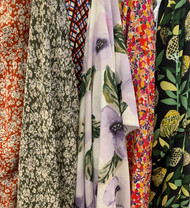Rayon and Viscose are made from plants
Posted by Jo Morris on 24th Nov 2021
We stock top-quality rayon and viscose fabrics. It's very difficult to tell the difference between the two just by look and feel. Some customers assume the fabrics are synthetics, akin to polyester, but that's not correct: rayon and viscose derive from plants.
Rayon
Rayon is a bamboo or wood cellulose-based regenerated fibre, originally created to resemble the texture and feel of silk, which is why it is widely considered as artificial silk. However, depending on the processing that the fibres go through and their thickness, rayon can be made to resemble linen and cotton too.
While it is made from purified cellulose, which is a natural material harvested from wood pulp, rayon’s chemical processing is what makes it different from natural fibres such as cotton, wool or silk. The latter require no (or very little) chemical processing to be spun into yarn for textile use, whereas rayon depends on these processes to be turned into the yarn used for clothes and other textile products.
Rayon’s history dates back more than 100 years when, in the late 1800s, a number of scientists were looking to create a silk alternative. Count Hilaire de Chardonnet was the first to patent the “artificial silk” made from nitrocellulose fibres and, in 1885, Georges Audemars, called the cellulose-derived fibers “Rayon”.
Rayon is used for both clothing and household textiles, typically curtains and sheets. Due to its versatility it has also been used in the medical field for surgical products. Its main characteristics include breatheability, ease of dyeing and colour-fastness, its easy and cost-effective manufacturing, and high versatility in production and use.
Viscose
Viscose is a type of rayon, originally created in 1883 by Edward John Bevan and Charles Frederick Cross. The main difference between the two fabrics is in the manufacturing process.While rayon’s raw materials can be either bamboo or wood cellulose, viscose is derived from wood cellulose and plant fibres, which are made into a viscous liquid that then undergoes a series of chemical processes.
Similar to cotton in structure and feel, viscose is primarily used in clothing and household textiles. It is an anti-static fabric that is also quite absorbent to both moisture and colour, which makes it very easy to dye. It is hypoallergenic and highly breatheable, a fabric capable of keeping you cool in warm weather and providing a basic level of insulation in cold temperatures.
(Source: Casual Geographical.com)

